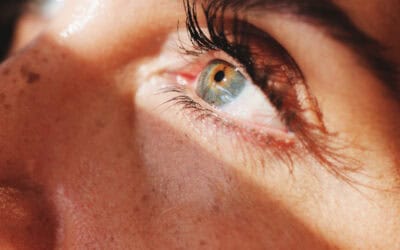Standard school screenings miss up to 75% of students’ eye problems. This startling reality means countless children sit in classrooms struggling with vision issues that directly sabotage their learning and development. Your child could be among them.
The scope of this problem extends far beyond what most parents realize. Nearly 25% of school-aged children have vision problems that impact their learning and development, according to an NIH-supported study. While over 6% of children under 18 in the United States carry a diagnosed eye or vision condition, the actual number affected is likely much higher as many cases may remain hidden from parents and teachers.
Your child’s academic performance and ability to retain material suffer when eye health issues go unaddressed. The most common vision problems in school-age children are nearsightedness (myopia), farsightedness (hyperopia), and astigmatism. These or other potential vision issues can all be detected with a thorough back-to-school eye exam.
What makes this situation particularly challenging is that children often remain unaware their vision is compromised. They’ve never experienced clear sight, so blurry or strained vision feels normal to them.
This guide will help you recognize warning signs of vision problems in your child, understand practical steps you can take at home to protect their eyesight, and discover why professional eye care forms the foundation of academic success this school year.
Understanding Vision’s Critical Role in Your Child’s Education
Vision serves as the primary gateway through which your child absorbs classroom learning. Think of your child’s eyes as information collectors, while their brain does the complex work of processing, understanding, and storing what they see for future use.
How your child’s brain processes visual learning
Around 80% of a child’s learning occurs through their eyes, making vision far more than just “seeing clearly.” Your child’s visual system works as an intricate network where eyes capture information and the brain interprets meaning. Approximately 60% of the brain handles vision-related tasks compared to just 8% for touch and 3% for hearing.
When your child looks at a math problem on the board, their visual system performs multiple simultaneous tasks: focusing on the text, tracking across lines of numbers, coordinating both eyes to work together, and processing the information into meaningful concepts their brain can understand and remember.
Classroom demands place particular stress on developing visual systems. Most school activities require sustained near-vision work rather than distance viewing, forcing young eyes to work harder throughout the day.
When vision problems go undetected, the consequences ripple through your child’s entire life.
When vision problems go undetected, the consequences ripple through your child’s entire life, affecting not just academics but also potentially reducing employment opportunities, creating increased financial hardship, and compromised emotional and social wellbeing.
The hidden connection between vision problems and classroom behavior
Up to 60% of students labeled as having learning problems actually suffer from vision difficulties. This staggering statistic reveals how often vision issues masquerade as behavioral concerns or learning disabilities.
Your child might appear hyperactive, inattentive, or disruptive when they’re actually struggling to see clearly. Vision problems can perfectly mimic ADHD symptoms, including hyperactivity and distractibility. What looks like defiance or lack of interest often stems from visual frustration.
Consider what happens when your child can’t see the board clearly: They might ask classmates for help, appearing disruptive. They could avoid participating in discussions out of self-consciousness about their difficulties. They may become frustrated and give up on visually demanding tasks, seeming unmotivated. Some children develop withdrawn behaviors as they struggle silently with unclear vision.
Teachers consistently notice dramatic behavioral improvements when students receive proper vision correction. One educator observed that children who previously interrupted class to ask peers for help stopped this behavior entirely after receiving glasses.
Why standard vision screenings miss critical problems
A child can pass basic vision screenings yet still have significant vision problems that interfere with learning. Most school screenings focus solely on visual acuity, which tests whether your child can see letters clearly at a distance, however this is just one piece of the visual puzzle.
Successful classroom learning demands multiple integrated visual skills working together seamlessly: the ability to focus eyes at different distances, track smoothly across lines of text, coordinate both eyes as a team, and process visual information efficiently. Your child might have “perfect” 20/20 vision yet struggle with these essential visual functions that directly impact reading, writing, and comprehension.
This explains why a comprehensive eye exam, and not just a basic vision screening, becomes essential for identifying the full range of vision problems that could be sabotaging your child’s academic performance.
Warning Signs Every Parent Should Recognize
Spotting vision problems early can save your child from months or years of academic struggle. These warning signs often appear subtle at first, but knowing what to watch for helps you take action before small problems become bigger obstacles.
Frequent squinting or eye rubbing
Your child’s hands may give you a hint about their vision. Frequent eye rubbing typically signals discomfort or significant visual effort. This behavior often reflects blurred vision from an uncorrected refractive disorder or local irritation such as dryness. Persistent eye rubbing might also indicate conditions like dry eyes or allergic conjunctivitis, which interfere with clear vision.
Squinting is an indication of your child’s attempt to see more clearly, especially for distant objects. When children squint consistently, they’re working harder than they should to focus their vision.
Avoiding reading or losing focus quickly
Does your child suddenly lose interest in homework, books, or projects that require sustained visual attention? This avoidance often masks underlying vision difficulties. Children with vision issues commonly avoid reading, drawing, or other close-up activities.
Children with vision issues commonly avoid reading, drawing, or other close-up activities.
What appears as lack of interest may actually be frustration from vision-related difficulties rather than behavioral problems. Your child isn’t being difficult—they’re experiencing genuine discomfort that makes visual tasks challenging.
Complaints of headaches or eye strain
When your child complains of headaches, especially after schoolwork or screen time, pay attention. Eyestrain commonly causes headaches along with sore, watery, or dry eyes. The pain typically centers behind or around the eyes, and the area might feel sore or tired.
During close-up tasks, eye muscles work harder to focus, becoming fatigued just like any other muscle. Children may complain about feeling dizzy, having headaches, or feeling sick after sustained visual work.
Holding books or screens unusually close
When children consistently hold reading materials very close to their face, it often indicates vision difficulties. This compensatory behavior helps them see more clearly despite visual impairment.
Any child who regularly positions themselves too close to screens or books should be promptly evaluated by an eye care professional.
Losing their place while reading
Children with vision problems frequently lose their place while reading. This difficulty tracking words across a page may signal several potential vision issues, including a lazy eye. These tracking problems significantly impact reading comprehension and learning efficiency, turning what should be an enjoyable activity into an unnecessarily challenging task.
Don’t wait for your child to complain about their vision. Many children assume everyone sees the world the same way they do.
Simple Steps You Can Take to Protect Your Child’s Vision
You don’t have to wait for problems to develop. Taking proactive steps at home can significantly reduce your child’s risk of vision problems while protecting their eyesight for years to come.
Encourage outdoor play to reduce myopia risk
Nearsightedness among children has reached alarming levels, with rates nearly doubling since 1971. The good news: research shows that children who spend at least two hours outside daily experience less myopia development and progression.
Outdoor time works regardless of weather conditions: cloudy days provide the same benefits as sunny ones. Think of it as essential as eating vegetables. Encourage your child to play outside, ride bikes, or even do homework outdoors when weather permits. Natural light exposure seems to protect developing vision in ways scientists are still investigating.
The eye doctors in Pittsburgh at Chang Eye Group recently published more information about myopia in children and how you can help protect your child’s eyesight with effective long-term vision care.
Limit screen time and follow the 20-20-20 rule
Digital eye strain has become a serious concern for children spending hours on screens for school and entertainment. Implement the 20-20-20 rule: every 20 minutes, have your child look at something 20 feet away for 20 seconds. This simple practice relaxes eye muscles and reduces fatigue.
Beyond this basic rule, establish healthy boundaries by removing screens from bedrooms and limiting use before bedtime. Adjust screen brightness to match room lighting and position computers so window light doesn’t shine directly on screens. These measures require no expensive equipment, it’s just consistent practice that you can start early with your school age children.
Serve foods rich in vitamins A, C, and E
Your child’s nutrition directly impacts their eye health. Specific nutrients provide powerful protection for developing vision:
- Vitamin A (retinol): Found in carrots, sweet potatoes, spinach, egg yolks, and dairy
- Vitamin C: Present in citrus fruits, strawberries, bell peppers, and broccoli
- Vitamin E: Available in almonds, sunflower seeds, and avocados
These nutrients act as antioxidants that help prevent oxidative stress responsible for many age-related eye conditions. Make these foods regular parts of your child’s diet rather than relying on supplements.
Create a well-lit, vision-friendly study space
Proper lighting forms the foundation of good vision habits. Natural light works best, but ensure artificial lighting isn’t too harsh or dim. Set up a consistent study area where supplies stay in the same place.
Position your child sitting upright at a desk or table with back support rather than lying down, which promotes passive reading. This approach protects vision while establishing effective study habits that will benefit your child throughout their academic career.
Professional Eye Care: Your Child’s Academic Insurance Policy
Up to 75% of children with vision problems are not identified with common school vision screenings. Moreover, over 60% of children that have an issue caught in school screenings do not receive follow-up diagnosis from an eye doctor. This gap between detection and treatment represents lost opportunities to protect your child’s learning potential.
A comprehensive eye exam serves as your child’s strongest defense against undetected vision problems that can sabotage academic success.
What happens during a student eye exam
A comprehensive eye examination goes far beyond the basic vision screening your child receives at school. An eye doctor will evaluate visual acuity, binocular vision, eye tracking, convergence, color vision, and complete ocular health.
These thorough examinations utilize specialized equipment to examine external eye structures and internal components like the retina and optic nerves.
Your eye doctor will assess how well your child’s eyes work together, track moving objects, and focus at different distances. These visual skills form the foundation for reading, writing, and classroom learning that basic screenings simply cannot measure.
School screenings miss critical problems
School vision screenings primarily test distance visual acuity using basic tools like the Snellen chart (usually shown as the big “E” at the top). However, these limited assessments cannot identify many critical vision problems affecting learning.
What makes this particularly concerning is that screenings are often conducted by volunteers with minimal training, whereas thorough exams are performed by qualified eye care professionals. Your child might pass a school screening yet still struggle with focusing problems, eye coordination issues, or tracking difficulties that directly impact their ability to learn.
Timing your child’s eye exam
The American Optometric Association recommends children have their first eye exam at 6 months, another at 3 years, before starting school (5-6 years), and annually thereafter. Children with risk factors like premature birth, family history of vision problems, or academic difficulties might need more frequent evaluations.
Don’t wait for your child to complain about vision problems. Many children adapt to poor vision because they don’t know what clear sight should look like.
Schedule an eye exam in Pittsburgh at Chang Eye Group to ensure your child starts the school year with optimal vision health.
Your Child’s Vision Deserves Priority This School Year
Your child’s academic success depends more on clear vision than most parents realize. Throughout this guide, we’ve explored how undetected eye problems masquerade as learning difficulties, behavioral issues, and academic struggles. The reality is sobering: 75% of vision issues go undetected by standard school screenings, leaving countless children to navigate their education with compromised sight.
Recognizing warning signs like frequent eye rubbing, headaches, or reading avoidance gives you the power to intervene before vision problems derail your child’s learning. Simple home strategies such as encouraging outdoor play, implementing the 20-20-20 rule, and creating proper study environments can provide meaningful protection for developing eyes.
Perfect 20/20 vision doesn’t tell the whole story. Many children pass basic vision screenings yet struggle with essential visual skills needed for reading, writing, and classroom success. This gap between screening results and actual visual function explains why thorough eye examinations remain critical for detecting the full range of vision problems affecting academic performance.
Your action today shapes your child’s educational tomorrow. Schedule a comprehensive eye examination before school begins or early in the academic year. This single decision could transform frustration into confidence in the classroom for your child. Remember that clear vision provides the foundation for everything your child will learn, discover, and achieve throughout their educational journey.
Don’t wait for academic struggles to reveal hidden vision problems. Chang Eye Group has two convenient locations in Pittsburgh that provide comprehensive eye exams designed to identify and address vision issues before they impact your child’s learning. Our experienced team understands how vision connects to academic success and offers family-friendly care that puts both you and your child at ease. Call Chang Eye Group today to ensure your child starts this school year with the clear vision they deserve for academic success.
FAQs
Q: What is the 20-20-20 rule for eye health?
A: The 20-20-20 rule is a simple technique to reduce digital eye strain. Every 20 minutes, take a 20-second break to look at something 20 feet away. This helps relax eye muscles and reduce fatigue, especially important for children spending extended time on screens.
Q: How can parents help protect their children’s eyes?
A: Parents can protect their children’s eyes by encouraging outdoor play, limiting screen time, serving foods rich in vitamins A, C, and E, and creating a well-lit study space. Regular comprehensive eye exams are also crucial for detecting and addressing vision issues early.
Q: What are common signs of vision problems in children?
A: Common signs include frequent eye rubbing or squinting, short attention span, avoiding reading, complaints of headaches or eye strain, holding books or screens too close, and losing place while reading. If you notice these signs, it’s important to schedule an eye exam.
Q: How often should children have eye exams?
A: The American Optometric Association recommends eye exams at 6 months, 3 years, before starting school (5-6 years), and annually thereafter. Children with risk factors or academic difficulties may need more frequent evaluations.
Q: Why is a comprehensive eye exam better than a school vision screening?
A: Comprehensive eye exams evaluate multiple aspects of vision health, including visual acuity, binocular vision, eye tracking, and ocular health. School screenings primarily test distance vision and can miss up to 75% of vision problems that affect learning and development.






